June 2001 – June 2002
Here are excerpts from the Minutes of the meetings of the Depleted Uranium Firing Environmental Review Committee which relate to the firings at at the Kirkcudbright Range, near Dundrennan, Dumfries and Galloway.
An introduction to these Minutes is here.
Acronyms:
KTA, Kirkcudbright Training Area, Ministry of Defence (MOD)
DERA, The Defence Evaluation and Research Agency, established in April 1991 as part of the MOD. In July 2001, DERA was split into two organisations:
QinetiQ, a privatised commercial company, and
DSTL, Defence Science and Technology Laboratory (MOD)
RO, Royal Ordnance
BNFL, British Nuclear Fuels Ltd.
EA, Environment Agency
SEPA, Scottish Environment Protection Agency
DTEO, Defence Test and Evaluation Organisation (MOD)
PLSD, Protection and Life Sciences Division (MOD)
CDA, Centre for Defence Analysis (MOD)
D SEF Pol, Directorate of Safety, Environmental and Fire Policy (MOD)
DG(Nuc), Director General (Nuclear) (MOD)
DUWG, Depleted Uranium Working Group (MOD)
Excerpts from Minutes of the 26th Meeting of the Depleted Uranium Firing Environmental Review Committee (DUFERC) on 20 June 2001

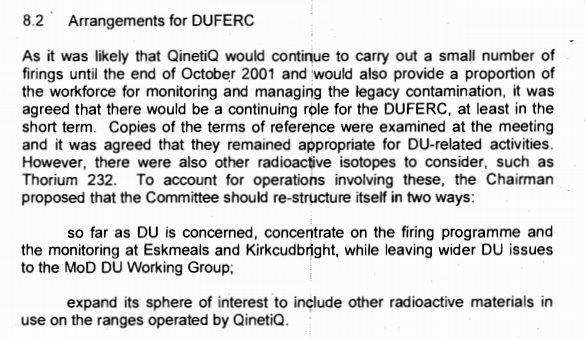
… It had been agreed that DERA/QinetiQ Ranges would continue to require a committee to regulate operations involving DU. However, now that the MoD Working Group was in existence, DUFERC would take on a less wide-ranging role.
… It had been agreed that DERA/QinetiQ Ranges would continue to require a committee to regulate operations involving DU. However, now that the MoD Working Group was in existence, DUFERC would take on a less wide-ranging role.
(Redacted name) detailed the intended firing programme, but warned that it was very much subject to restrictions preventing the spread of foot and mouth virus. Currently, just three more trials were planned, a reduction from the potential seven mentioned previously [at Raeberry, Ballig and Doon Hill] … The proposed radiological survey at Kirkcudbright had unavoidably been postponed due to the foot and mouth restrictions, and was not expected to take place until these were lifted in September.
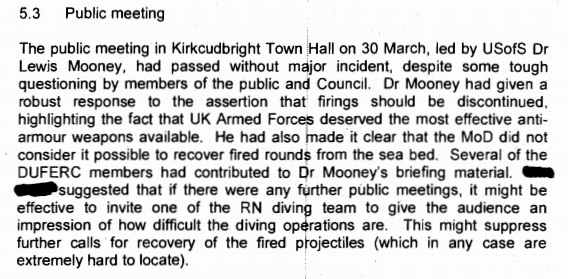
(DU Gardens) (Redacted name) described the highly successful operation carried out by the RN Northern Diving Group … Six out of ten remaining sample rods had been recovered. The location of the remaining four had been narrowed to a small area. The buried samples had been re-located, the co-ordinates recorded by GPS… (The mass loss to corrosion was reported).
The Chairman proposed that the results obtained from open water and buried samples to date, plus those which could be expected in future, would provide sufficient information to enable an estimate to be reached of the time taken for complete corrosion of rounds. There was also the open question of who would pay for the design, construction and placement of a new rig, once DERA had entered the private sector.
(Redacted name) raised the possibility of the divers searching in known impact areas to try to recover recently-fired rounds for experimental purposes … (Redacted name) agreed to provide an estimated position of the splash point for the next firings.
Full text here.
Excerpts from Minutes of the 27th Meeting of the Depleted Uranium Firing Environmental Review Committee (DUFERC) on 12 September 2001

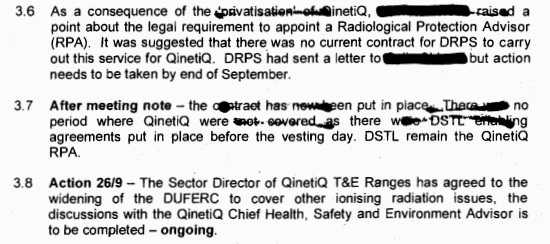
(DU gardens update) The July dive took the schedules buried (redacted words) the Northern Diving Group were unable to carry out a proper search of the sea bed due to time constraints. Several dives were disrupted or abandoned due to firing on the Kirkcudbright range…The analysis of the recovered buried samples showed that not much more corrosion had taken place since the previous recover, and no trends could be deduced so far… (Samples from the land gardens) have also been recovered. The solid cores at Kirkcudbright are showing a hard black “rind” surrounding the metal with an outer yellow coating of soluble products around this rind. Soil samples from under the samples are showing that there is some transport of radioactive material through the soil and the products are dispersing slowly.
Full text here.
Excerpts from Minutes of the 28th Meeting of the Depleted Uranium Firing Environmental Review Committee (DUFERC) on 4th of December 2001

(Redacted name) to seek out the owners of the DU currently stored at Kirkcudbright – (Redacted names) at Fort Halstead was identified as the owner of at least some of the FU … (Redacted name) would follow up this issue with DSTL (redacted words) as to the implications of keeping the DU stored at both Eskmeals and Kirkcudbright. With continued storage of so much DU, the site would be forced to look at instigation REPPIR regulations and exercising with local authority emergency services, this would add to the price of storage that the “customer” will need to cover.

Full text here.
Excerpts from Minutes of the 29th Meeting of the Depleted Uranium Firing Environmental Review Committee (DUFERC) on 6th of March 2001
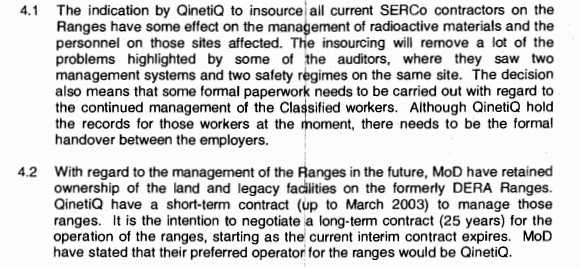
Kirkcudbright Report: All activities associated with the firing of DU have now ceased, but the routine sampling will continue. The Ballig target is still in place. A survey has been carried out to see how the range stands, now there are no plans for further firings. The Range is still waiting for the DRPS 2000 and 2001 survey reports. It is the intention of the Range to ask for funding to allow sampling to continue.
A useful document has been produced containing the number of DU rounds fired over the years. This has taken some time to collate, but it is the intention to present this as the “standard work” on the subject, and incorporate the information into the DU database being compiled by GVIU. The document contains not only the number of rounds, but also where they were fired from and the splash point data.
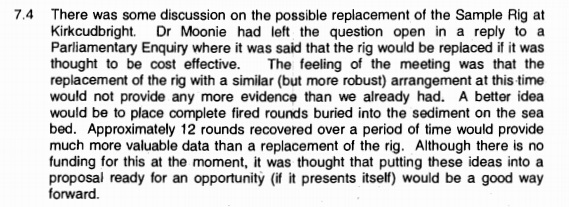
Full text here.
Excerpts from Minutes of the 30th Meeting of the Depleted Uranium Firing Environmental Review Committee (DUFERC) on 2 June 2002
There are no minutes available.


